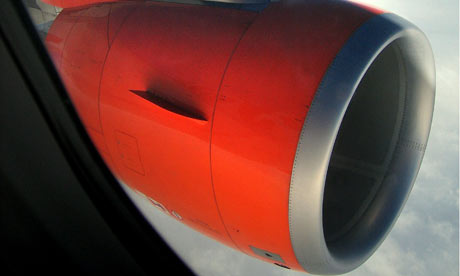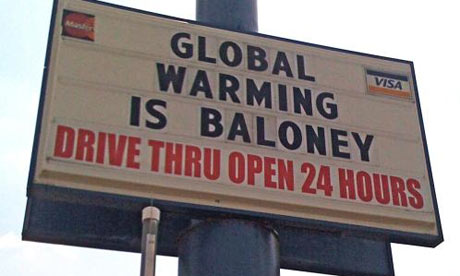Climate change protesters who ambushed and hijacked a power station coal train failed to convince a jury today that their actions were justified by the "imminent threat" of devastation from global warming.
The 22 men and women, including a senior university lecturer, teachers and film-makers, were convicted - after less than two hours of deliberation - of obstructing the service carrying 42,000 tonnes of coal to Drax in North Yorkshire last June.
Their hopes of repeating the "Kingsnorth Six" judgment last September, when activists who defaced a power station chimney were acquitted by a Kent jury, were dashed by a judge, who refused to admit arguments that the hijack was "necessary and proportionate to prevent the greater crime of carbon pollution".
Although he eventually allowed an unexpectedly large amount of evidence about climate change to be heard, Judge James Spencer refused to let expert witnesses such as Nasa scientist, Prof James Hansen, address the seven women and five men on the jury at Leeds crown court. In a pre-trial ruling he said that to do so would allow the protesters "to hijack the trial process as surely as they hijacked the coal train".
He did however compliment the group, who conducted their own defence, on making an "eloquent, sincere, moving and engaging" case to the court. After the verdicts, he said that sentencing in early September would definitely not include jail terms, but was likely to be community service.
The 22, plus a further five protesters who earlier pleaded guilty and two who are ill but expected to submit guilty pleas in due course, will however face hefty financial penalties. The crown is applying for both its costs and £36,000 compensation for cleaning up coal shovelled on to the tracks during a 16-hour standoff with police.
After the verdict, one of the 22, Dr Louise Hemmerman, 31, said: "The judge declared from day one that climate change was irrelevant to the trial, despite the fact that it was the sole reason for doing what we did."
Another of the group, Jonathan Stevenson, 27, who works for a development charity, said: "This won't be the last case where climate protesters are in court for taking peaceful direct action, and while some judges may think climate change is irrelevant, they won't be able to hold back the tide forever."
Stevenson asked the judge after the verdicts if an order banning the defendants from power stations would apply more widely, to include roads. Judge Spencer replied with a smile: "I would steer clear of demonstrations, all of you, until this case is completely over. Try to find some other activities to do on your holidays."
Hansen, head of Nasa's Goddard Institute for Space Studies, whom the defendants had intended to call to the stand to speak about the science of climate change, said: "Civil resistance is not an easy path, but given abdication of responsibility by the government, it is an essential path."
Hansen was arrested last week for his part in a protest over mountaintop coalmining in West Virginia. He has previously said that direct action is necessary because the democratic process is not bringing about policy change fast enough.
The chief crown prosecutor for North Yorkshire, Rob Turnbull, said: "While the CPS [crown prosecution service] respects the rights of individuals to lawfully protest, it takes a serious view of criminal activity which targets those carrying out lawful activities." He defended Judge Spencer's pre-trial ruling on the grounds that no one was in such immediate danger from global warning that hijacking a coal train was "proportionate".
"The judge said that if the power station contributed to global warming, and all that entailed, it was for the government to attend to and not the protesters. He also said that no reasonable jury could conclude that the crime these defendants allegedly committed was either reasonable or proportionate when there were democratic processes available in this country for political change."
The 22 were acquitted of actually stopping the train, after evidence that no one knew which of them had donned fake railwaymen's uniforms and used red flags to bring it to a halt. The ambush stopped the train right on a bridge over the river Aire, whose girders gave protesters the means to clamber up and use 15 shovels to start unloading coal.
Passenger and freight services in the area were disrupted for two days, but Drax generated power normally throughout.
Those convicted were: Theo Bard, 24, Amy Clancy, 24, Brian Farelly, 32, Grainne Gannon, 26, Bryn Hoskins, 24, Jasmin Karalis, 25, Ellen Potts, 33, Bertie Russell, 24, Alison Stratford,26, Jonathan Stevenson, 27 and Felix Wight, all of London, Melanie Evans,25, Matthew Fawcette, 34, Robin Gillett, 23, Kristina Jones 22, Oliver Rodker, 40 and Thomas Spencer,23, all of Manchester, Paul Chatterton, 36, and Louise Hemmerman, 31, of Leeds, Melanie Evans, 25, of Stockport, Paul Morozzo, 42, of Hebden Bridge, Christopher Ward, 38, of Newport Pagnell and Elizabeth Whelan of Glasgow.
The five who pleaded guilty earlier were: Theo Brown, 22 and Clemmie James, 24, of London, Malcolm Carroll, 53, of Stafford, Thomas Johnstone, 25, of Liverpool and Paul Mellett, 29, of Colerne, Wiltshire. The two have indicated they will plead guilty when well are Caroline Williams, 25, of London and Sam Martingell, 24, of Leeds.









 View More Images
View More Images











